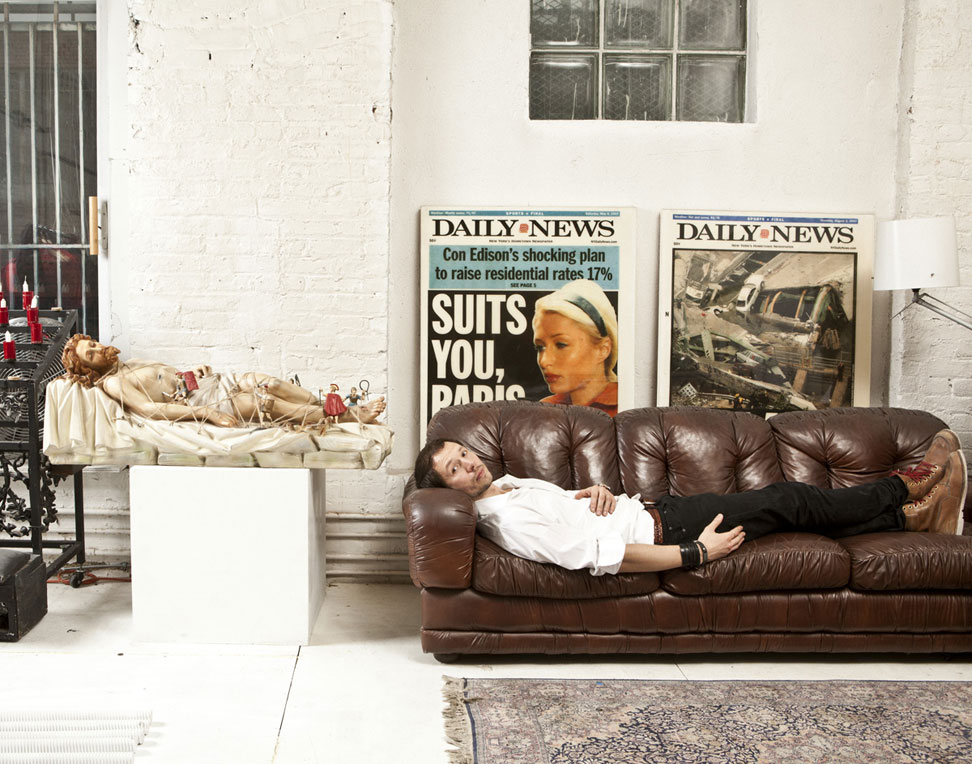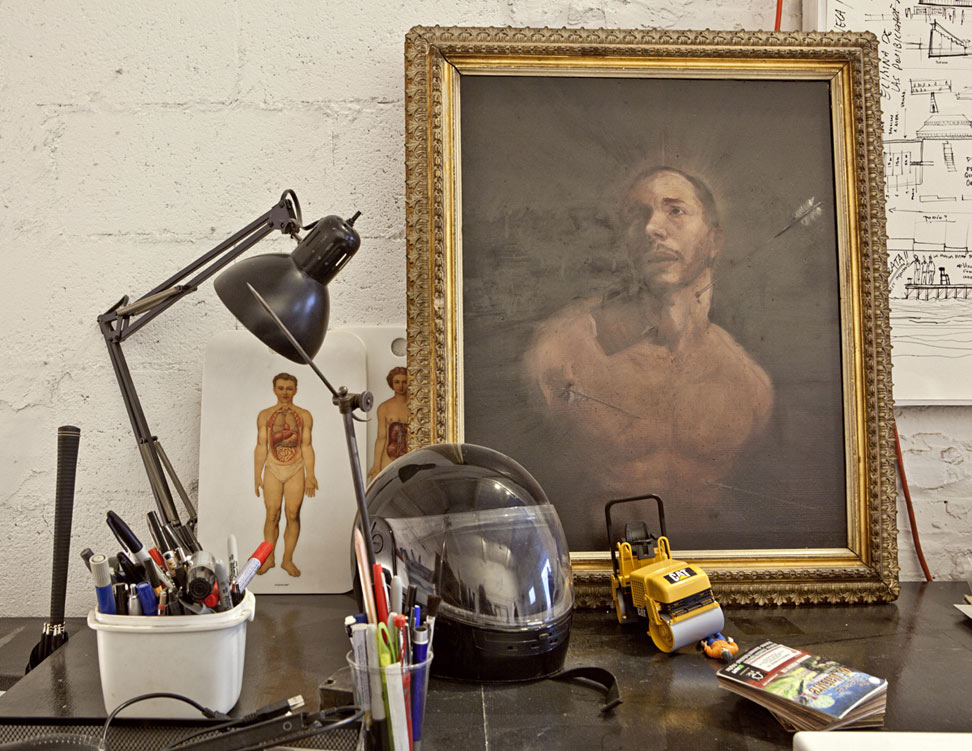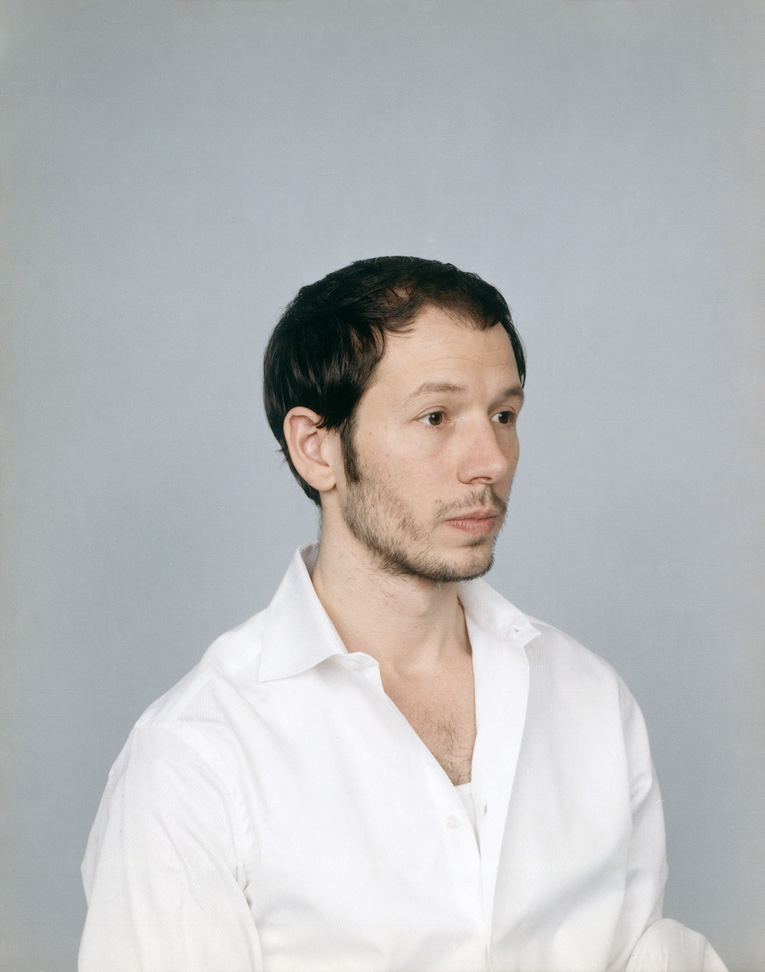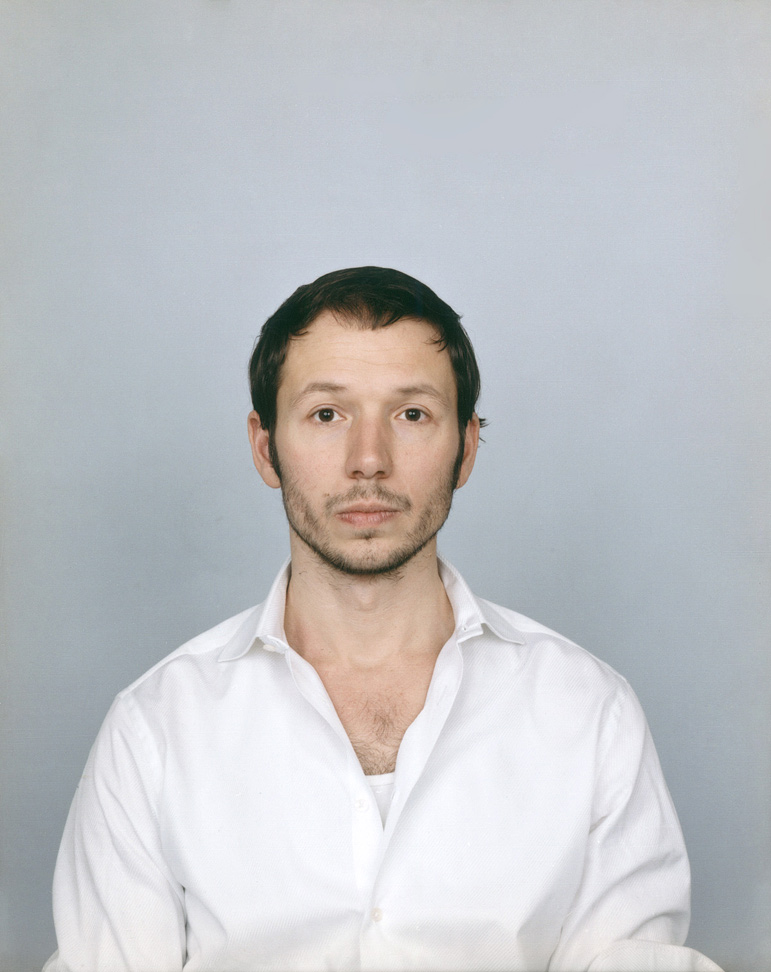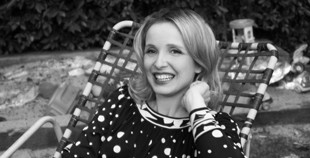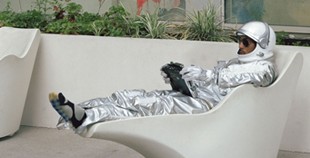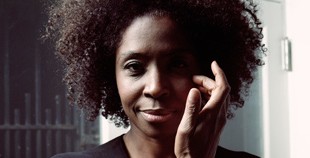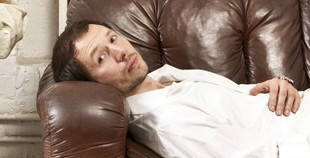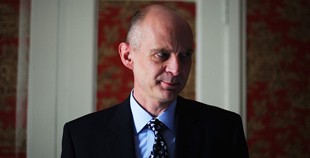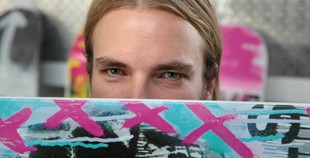
Ruler of A Parallel Visual Universe Questions The Distinction Between Art And Design
Interviewed by Amy Routman / Photographed by Stefan Ruiz
Sebastian Errazuriz is not limiting himself. He is attempting to be a neo-Renaissance man. And his rigor is inspiring. He is questioning the distinction between art and design with his functional art and expressive design approach. He is a jester, an advocat, a director, and a craftsman. The result is that through his projects he gets his audience to think, laugh, and live.
Errazuriz was born in Santiago, Chile, raised in London, and has studied art, design and film. His rigor drives his ideas-based approach to his work in sculpture, public art, product design, furniture, and fashion. He became, at the age of 28, the second living South American to have work at auction at Sotheby’s Important 20th Century Designs.
Errazuriz’s diverse feats have included rescuing a cow and dramatically positioning it atop the city in his project, The Day Cows Fly. He’s staged Memorial of a Concentration Camp in Chile’s National Stadium by planting a magnolia tree in the center of the field where dictator Pinochet had imprisoned, tortured, and killed thousands of political prisoners.
His Nature Morte Dining Table, made up of an overturned tree—limbs partially intact–serving laterally as the base is just one work that caught the attention of the design world. His Duck Lamp appears the result of an unlikely mash up of a taxidermic goose and a drafting light. His Shoe Pants, Hand Jeans, and Zipper Dress extend his whimsical approach to wearable designs.
Errazuriz invited me to his studio to talk about his work. The workshop, located in a warehouse in Williamsburg, is laid out with a woodshop, a main workspace, and loft. There was an array of creativity throughout which included a woodworker working on a Porcupine cabinet, his Bear Fur coat displayed in his private work area, and Opera d’Inferno, a surrealist play on (and in) a fireplace mantle propped up downstairs in the studio among his assistants.
As we sat to start the interview in the loft, I had a clear view of an upright piano dangling from a rope over the workspace below. And a stuffed raven perched on the back of his desk chair. Were these art pieces in progress? Physical reminders about tenuousness of life? Studies in his search for the sublime? Beyond the piano, the wall that spanned both levels of the space held a stunning grid of dozens of sketches on paper—all workups that serve as documents ideas in progress. Central to his process, Erraruriz talked about the wall, as well as his work, his experiences, and his history.
How long have you been in this studio?
I’ve been here four years. For the moment it works. I have the wall, the space to assemble, and the computers.
How long have you been in New York?
About six years.
How often do you go back to Chile?
Maybe six times a year. I have workshops and sometimes I have a couple prototypes that I start there because they are too big. Handwork is super expensive here. For projects that are time consuming—between having someone work over here for months or over there on a piece–often it is better to ship it on the plane and it will be cheaper that way.
You’ve also spent time in England?
Yes, as a kid growing up. My father was doing his PhD so my whole family went there. It was a nice upbringing. My dad is this obsessive character in the arts. It was basically like growing up in the circus.
Why?
I have a couple of friends whose parents are huge collectors and I can say, “OK, maybe that dude had more contact with contemporary art than I did.” But every single weekend we would go to the Tate or The National Gallery and I would be expected to analyze and criticize paintings by the Masters.
And how old were you?
Five. I always tell this story. If we were looking at a Turner—and he is not an easy painter to analyze–I was supposed to guess which of the paintings in the room was the first in the series and which one might have been the last. I was supposed to show where the painting had started, where it had finished, and the focal point of the painting. I had to find little things like how certain colors were repeated. But, maybe the trickiest, I was supposed to be able to distinguish where the artist had been painting freely and where he had been doubting himself.
Your father really trained your eye. Was he an artist as well?
I think he wanted to be, but after three years of studying art he went into aesthetics. His PhD was in art education. Probably every theory he was studying he tested on me. I was the oldest kid–I was his guinea pig! I couldn’t copy a drawing from a cereal box, for example. My father would tell me, “It is very good, but I don’t like you to doing that. Do your own ideas!”
Do you bring him into your process?
He’s finally proud. But for a long time…he never said anything until I was maybe 26 years. I was having a piece in a group show at Chile’s National Museum of Fine Arts. Though I’d won all these competitions and done all of this work, he never told me anything was good. Nothing! Ever! We went to have a beer and he said he was afraid to tell me anything was good for I’d then feel comfortable. So, for a long time I was trying to get his approval. There were little dedications to him. For a lot of the public art projects I would hire musicians that would play in the subway classical music. My name is Juan Sebastian because my dad is a fan of Bach. So, I would have them playing Bach at the opening for my dad as a present. Today I don’t care as much. I understand that he is an expert in his area and I’ve earned my space in mine.
What about your mother?
She floats on her own cloud. She was incredibly charming. She was a kindergarten teacher. Very reassuring, very loving. But always in her own cloud!
You worked with your brother so you must be close?
We are four brothers–all boys. I have my four lines tattooed. My brother has it, too. The little ones didn’t dare to do it—they chickened out! Tomas studied architecture. He would tell me when things were wrong with no sugarcoating. He always acted as a nice compass.
Do you think being here allows you more freedom to create who you are versus in Chile?
Sure. Chile is very conservative. Religion is very strong. When I was there I had made myself a name. I had my own tv show, radio show, and newspaper column. I was a bit of a figure. So, unfortunately, with that I would go to the supermarket and some lady would tell me that they liked what I’d talked about. There was a certain visibility that I think was not that good. I also think– it was almost like the new rich–I became too happy with myself in terms of general compliments and overall status. It is nice to be ‘no one’ here.
What do you think about being famous or successful at a young age?
I think it was really good because it allowed me to stumble in a controlled environment. I was a bit of a dick with my friends for a while, unfortunately! I was too into it. I’m certain it would happen to anyone who suddenly gets a lot of attention and praise. But if it were ever to happen again it wouldn’t influence or change me.
Do you think coming here has changed your work?
Not really…in terms of what I dare to do and don’t. On the one side, I can do whatever I want here in the sense of I can dress whatever way I like and no one is going to look. That is very nice. But, at the same time, Americans are surprisingly puritanical and afflicted by any attack that they don’t like. The discourse within the arts or design is very far behind what is happening in London, for example. They really discuss and debate ideas. So, it is tough here and then it is tough not being from here.
In Chile for a couple of projects I risked going to jail and I was ok with it. So a few days in jail is no big issue. Over here, I would get kicked out of the country. So, it is very weird to create being afraid.
Are you planning to do more public art here?
Yes. But there are so many restrictions. For example, to move the tree in the middle of the stadium [for Memorial to a Concentration Camp] I get a huge truck with a tree sticking out of it. I move enough connections to get a couple of cops on motorcycles to go. There wasn’t any insurance involved. We made a route so we’d be sure we wouldn’t hit any telephone cables and that was about it! If I had a show here in my studio I’d probably need insurance for the amount of people that came. There are a lot of technicalities, there are a lot of moral issues, there are a lot of legal issues that make it hard. But I’m planning anyway.
You have something in the works?
I’m trying to do a piece that is related to people with disabilities. Like most of the works that I do I’m trying to get you to look at something that was always there that you just hadn’t noticed. Or, I try to get you to look at something you had already seen but with other eyes. I like the idea of a social component.
You did something like this in Chile [Life Swings]?
It is along those lines. Imagine if you could experience a public art project where you meet a guy with no legs –who you normally would have seen in the subway asking for money or some situation where you physically looked down on them because they are in a wheelchair. But you would be the one who felt trapped and uncomfortable while he was the one holding and containing you.
Your work often deals with mortality. Was there something that happened in your life that made you face it?
There is a family story. My grandfather had diabetes. My uncle had diabetes, too. And at the time–70 years ago–if you were diagnosed with diabetes it was a big deal. The chances of dying were pretty big. A small country in the bottom of South America was less evolved than anything over here. My grandfather had been an extremely methodical man; he was an old school gentleman. He looked after himself in a way that was very difficult for the rest of the family just because of the structure–like a little general. It allowed him to survive and be healthy. His son, who was studying architecture and was the artist of the family, was diagnosed with diabetes. He says, “I’ve seen my father strain his life second by second, pill by pill, scoop of food by scoop of food. I don’t want to live like that. I’d rather live the time I have at its most.” He died two years later.
As it turned out, I was the artist in the family and looked like my dead uncle. My grandfather would call me by his name by mistake. I lived for a while with my grandparents so I would shave and dress my grandfather within all his rituals. I would walk with him and hear his stories. So, I was always very aware of life and death and how short it is. I had the most beautiful and luckiest childhood ever! Under no circumstances was it tragic!
If you can look at everything that surrounds you and not just accept it the way it is, but see it, enjoy it, and imagine it could be different. And, if it could be different, how could it be? For me it is just a beautiful exercise where I have fun and it makes me feel alive if I’m able to create a tiny parallel universe of objects and things. I’m doing a little bit of that. I’m poking, I’m winking, I’m flirting. I’m inviting you to look again at stuff. With some things I will poke a little more than I should and I’ll try and steal a reaction from you. With others, I will softly try and get you to giggle. But they are all trying to connect, to show, to invite you to look again.
What are you working on now?
I’m working on ten different projects–it is always several projects in parallel. There is an entire wall of drawings in the back [of the studio]- that talks about a little bit of the process. I need to put ideas down on drawings as fast as they come without categorizing them or trying to decide if there is anything worthwhile. Then they all go up on the wall and wait.
The wall is quite tall!
There’s a ladder which I used to put up the sketches, but now there is a guy that does it because it take two days to put them up!
Do you sit in front of it and think?
I don’t sit, but I stumble upon them during my day. It is by their being up on the wall for a while that allows me to distance myself from them not get so excited about the new idea—to be able to evaluate them with more perspective and identify if there is something truly captivating and interesting that manages to stand the test of time.
Do you move them around?
They are up or a while. They get scanned first and then placed up for maybe six months. Then they all come down and get archived. That’s it! So, within that process there are a lot works where there is a certain component that fascinates me. It has been up there for a while. It haunts me enough so that I want to tackle it.
What have you started to work on?
We are doing a Freudian piece. We are working on a Rorschach test.
But, let me backtrack a bit…I work within design as an artist. I do the ideas that I want to do and then meet with people who are interested in mass-producing something. There are a few commissions, but, in general, it stays within whatever I want to do and the way I want to do it. There is even a diva aspect where if a collector requests a commission I give them a couple of proposals and if they don’t like what I’ve given, then that’s it!
So you don’t compromise?
It is like the girl that is dating the motorcycle kid with the leather jacket who is not going to be a good father, but he’s great in bed. That is why you would seek him in the first place! If you are seeking us it is hopefully because we are going to propose that thing you wanted in the beginning.
That sounds great, but…
Yes. It’s been hard, though. I am also interested in the languages of art and design. At what point do you start walking the line between one or the other? In general, there is an idea that if it is horizontal it could be design—a coffee table, for example. The moment you put it up on the wall it becomes a symbol of art—a painting, a graphic.
We are trying to do a piece that is almost like a bathroom cabinet, which is shallow in terms of depth, but it is a huge piece intended for the living room. It is fun because I’m purposely forcing a piece to have a function when it shouldn’t. It is exaggerated to an extreme just so we can do art within what would be still called design. I thought it was very interesting to have a piece where you were reflected –where you saw yourself. Everyone has a cultural fantasy of the Rorschach. You always think you are going to see something that you shouldn’t see looking into your own soul. So with this cabinet you’ll open up a series of doors until you find to this ridiculously shallow shelf where you can just have a few of your belongings.
So where are you with this?
We have started sketches. We are trying different materials. We are looking at different graphics. We don’t know exactly what we want, but that is part of what is interesting. Once we finish the graphics and have the idea of exactly what we want we’ll make a one-to-one scale in cardboard. I do that for every single furniture piece.
All your work has a high level of craftsmanship. Is that something you learned? Or acquired thru the process of making?
As I mentioned, my father did his PhD in art education. My grandfather loved making little model boats. There was always a little wood shop. A connection with using your hands. But, at the end of the day, it is a matter of working with materials and techniques you haven’t worked with before. Whenever a project is not properly executed there are distracting elements that make noise and that distance the idea from the viewer. I try to eliminate as many of those as possible so it is pure of the thought as the quick sketch I did at the start.
I studied design. I’ve worked with craftsmen. It is a challenge, too. I tell these guys that whatever we do…we aspire…that you shouldn’t be able to know whether it was made in 1950 or 2012. It is an important way of brushing off any fashion aesthetics.
If you see Karim Rashid’s work there is a clear aesthetics of the 90s that today makes his work dated. If you are working with ideas and symbols why would you also trap that project within a specific time unless you are referring to that time in particular? That is the first issue.
Also, there is a craftsmanship issue. It is understood that we don’t have the time, techniques, and budgets as before. But we should be able to roll whatever we make into Versailles and it has to defend itself. It is that pretentious! Obviously, ninety-nine percent of the works just don’t. But if you’ve seen Murakami’s or Jeff Koons’ exhibitions at Versailles you see these contemporary pieces manage to hold their own. There is a beauty and a genuine timelessness in that which you aspire to.
And other pieces?
There is a piece downstairs [Magistral] that is made out of corndog skewers. It took 6 weeks, 12 people to hammer in –just the skewers! That doesn’t include the CNC cutting and assembly. There was so much work involved it took probably three-and-a-half months of construction plus about five sets of blueprints.
They are all technically thought out. Like the Porcupine piece. We are assembling one of these downstairs. [The wood spines] open up in every direction. For all of them to open up they literally pass in a millimeter from hitting each other. There are so many technicalities to something that could be extremely simple.
You must enjoy the process of realizing the work beyond the ideas?
I guess in any job you can only learn so much in school. It is in the process…in the discovery that one learns. I’ve done everything from steelwork to marble carving depending the piece. For every piece we work with specialists. But at the same time, because the work is based on ideas, we are normally requiring someone who has always done the same thing to approach it from a different perspective. So, it is a process and a beautiful learning curve.
You have someone downstairs who works to make the jump from the cardboard to full scale models?
Yes, because, once you’ve figured out the prototype someone else can make it. My workshop in Chile can make one. I just tell them what color and so on and they can do it. But for any new thing there are many issues. Even though we are working with really good woodworkers, they can get lost trying to interpret our things. There will be issues we didn’t think of. It is better if we are there to make the decisions. Then there is an element of control and an element of surprise. So having someone with me is noisy, but there are earplugs for everyone!
Are you working on any products?
I am doing little products like this [Cutting Board Man] cutting board [with an anatomical drawing of a man with his organs exposed]. So, even in a little everyday product there is a little bit of a wink and getting you to look at certain issues that go beyond the aesthetics of the product.
You studied film – does that influence your work?
I don’t do film. I did work as a storyboard artist for a bit. It is extremely helpful to visualize the photos you want of every project. I think the photographic image it is important especially in today’s world because the way you photograph it will be completely vital to the people that don’t get to see it. A piece will be seen in person by 3,000 people but it will be seen by millions people over the internet. How they experience it…if the piece is going to be exhibited or not…depends on the photo.
I see you have the Bear Fur coat displayed here in your work area.
Do you know the Campana brothers? It was an homage to them. They did a chair with teddy bears in 2002 or so. I did it right after. I think it is very fun to do small winks and homages and nudges.
Does the variety of projects help the flow?
I don’t have time for bullshitting around. I love design. I love art. Many times I don’t know which one to pick. Should I sacrifice one over the other? Life is short! Fuck it! I’m going with both using everything I have. I want to be Damien Hirst in art and Mark Newson in design. Probably it is impossible, but I’m going for anything and everything! To have a process of work as opposed of an aesthetics of work is difficult.
How do you edit yourself?
Zaha Hadid told me that she loved this piece [Porcupine] but that the legs were horrible. I think she is totally right. You try to edit as an underdog. I know that it is going to be placed by a Zaha Hadid piece and she has two hundred people working for her. I imagine a team of German designers in little white coats. How do I put something next to her that looks decent? So, I’m always forced to edit up. For someone it might be good enough. I always need to push it even higher. Is there anything that is missing? Are the legs wrong? How can I push this a little bit more? And the wall with the sketches is the best editor. I had a piece of paper over the desk. Actually, I had two. One said, ‘”I don’t know why it is that we are in life, but I know it is not to have fun.” And the other one was something like, “Creativity is not enough. You need to look for the Sublime.” Both are very self righteous and pretentious little post-its that anyone could have. But if you think about it– creativity is just one part. It is almost like a one-liner. Once you see it, there is nothing else to see. If you can capture something else–a little reflection of us and who we are. It is timeless and has depth. You have to aim as high as possible even if you rarely grasp it.

